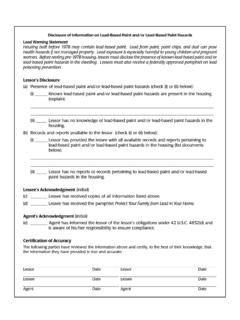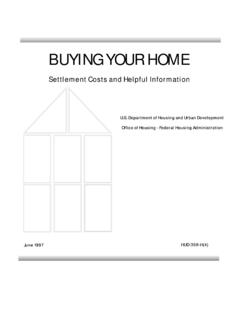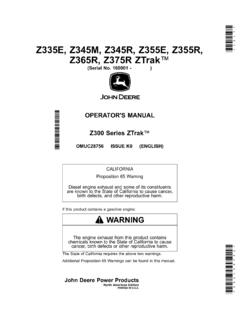Transcription of Lead in Your Home Brochure Booklet BW
1 IMPORTANT! Lead From Paint, Dust, and Soil in and Around Your Home Can Be Dangerous if Not Managed Properly Children under 6 years old are most at risk for leadpoisoning in your home. Lead exposure can harm young children and babies evenbefore they are born. Homes, schools, and child care facilities built before 1978are likely to contain lead- based paint. Even children who seem healthy may have dangerouslevels of lead in their bodies. Disturbing surfaces with lead- based paint or removinglead- based paint improperly can increase the danger to your family. People can get lead into their bodies by breathing orswallowing lead dust, or by eating soil or paint chips containing lead. People have many options for reducing lead , lead- based paint that is in good condition is not a hazard (see page 10). Protect Your Family From Lead in Your Home United States Consumer Product Safety Commission United States United States Environmental Protection Agency Department of Housing and Urban Development March 2021 Are You Planning to Buy or Rent a Home Built Before 1978?
2 Did you know that many homes built before 1978 have lead- based paint? Lead from paint, chips, and dust can pose serious health hazards . Read this entire Brochure to learn: How lead gets into the body How lead afects health What you can do to protect your family Where to go for more information Before renting or buying a pre-1978 home or apartment, federal law requires: Sellers must disclose known information on lead- based paint or lead- based paint hazards before selling a house. Real estate sales contracts must include a specifc warning statement about lead- based paint. Buyers have up to 10 days to check for lead. Landlords must disclose known information on lead- based paint or lead- based paint hazards before leases take efect. Leases must include a specifc warning statement about lead- based paint. If undertaking renovations, repairs, or painting (RRP) projects in your pre-1978 home or apartment: Read EPA s pamphlet, The Lead-Safe Certifed Guide to Renovate Right, to learn about the lead-safe work practices that contractors are required to follow when working in your home (see page 12).
3 Consumer Product Safety Commission (CPSC) The CPSC protects the public against unreasonable risk of injury from consumer products through education, safety standards activities, and enforcement. Contact CPSC for further information regarding consumer product safety and regulations. CPSC 4330 East West Highway Bethesda, MD 20814-4421 1-800-638-2772 or U. S. Department of Housing and Urban Development (HUD) HUD s mission is to create strong, sustainable, inclusive communities and quality afordable homes for all. Contact Ofce of Lead Hazard Control and Healthy Homes for further information regarding the Lead Safe Housing Rule, which protects families in pre-1978 assisted housing, and for the lead hazard control and research grant programs. HUD 451 Seventh Street, SW, Room 8236 Washington, DC 20410-3000 (202) 402-7698 This document is in the public domain. It may be produced by an individual or organization without permission. Information provided in this Booklet is based upon current scientifc and technical understanding of the issues presented and is refective of the jurisdictional boundaries established by the statutes governing the co-authoring agencies.
4 Following the advice given will not necessarily provide complete protection in all situations or against all health hazards that can be caused by lead exposure. U. S. EPA Washington DC 20460 EPA-747-K-12-001 U. S. CPSC Bethesda MD 20814 March 2021 U. S. HUD Washington DC 20410 17 U. S. Environmental Protection Agency (EPA) Regional Ofces The mission of EPA is to protect human health and the environment. Your Regional EPA Ofce can provide further information regarding regulations and lead protection programs. Region 1 (Connecticut, Massachusetts, Maine, New Hampshire, Rhode Island, Vermont) Regional Lead Contact EPA Region 1 5 Post Ofce Square, Suite 100, OES 05-4 Boston, MA 02109-3912 (888) 372-7341 Region 2 (New Jersey, New York, Puerto Rico, Virgin Islands) Regional Lead Contact EPA Region 2 2890 Woodbridge Avenue Building 205, Mail Stop 225 Edison, NJ 08837-3679 (732) 906-6809 Region 3 (Delaware, Maryland, Pennsylvania, Virginia, DC, West Virginia) Regional Lead Contact EPA Region 3 1650 Arch Street Philadelphia, PA 19103 (215) 814-2088 Region 4 (Alabama, Florida, Georgia, Kentucky, Mississippi, North Carolina, South Carolina, Tennessee) Regional Lead Contact EPA Region 4 AFC Tower, 12th Floor, Air, Pesticides & Toxics 61 Forsyth Street, SW Atlanta, GA 30303 (404) 562-8998 Region 5 (Illinois, Indiana, Michigan, Minnesota, Ohio, Wisconsin) Regional Lead Contact EPA Region 5 (LL-17J)
5 77 West Jackson Boulevard Chicago, IL 60604-3666 (312) 353-3808 Region 6 (Arkansas, Louisiana, New Mexico, Oklahoma, Texas, and 66 Tribes) Regional Lead Contact EPA Region 6 1445 Ross Avenue, 12th Floor Dallas, TX 75202-2733 (214) 665-2704 Region 7 (Iowa, Kansas, Missouri, Nebraska) Regional Lead Contact EPA Region 7 11201 Renner Blvd. Lenexa, KS 66219 (800) 223-0425 Region 8 (Colorado, Montana, North Dakota, South Dakota, Utah, Wyoming) Regional Lead Contact EPA Region 8 1595 Wynkoop St. Denver, CO 80202 (303) 312-6966 Region 9 (Arizona, California, Hawaii, Nevada) Regional Lead Contact EPA Region 9 (CMD-4-2) 75 Hawthorne Street San Francisco, CA 94105 (415) 947-4280 Region 10 (Alaska, Idaho, Oregon, Washington) Regional Lead Contact EPA Region 10 (20-C04) Air and Toxics Enforcement Section 1200 Sixth Avenue, Suite 155 Seattle, WA 98101 (206) 553-1200 Simple Steps to Protect Your Family from Lead hazards If you think your home has lead- based paint: Don t try to remove lead- based paint yourself.
6 Always keep painted surfaces in good condition to minimize deterioration. Get your home checked for lead hazards . Find a certifed inspector or risk assessor at Talk to your landlord about fxing surfaces with peeling or chipping paint. Regularly clean foors, window sills, and other surfaces. Take precautions to avoid exposure to lead dust when remodeling. When renovating, repairing, or painting, hire only EPA- or state-approved Lead-Safe certifed renovation frms. Before buying, renting, or renovating your home, have it checked for lead- based paint. Consult your health care provider about testing your children for lead. Your pediatrician can check for lead with a simple blood test. Wash children s hands, bottles, pacifers, and toys often. Make sure children eat healthy, low-fat foods high in iron, calcium, and vitamin C. Remove shoes or wipe soil of shoes before entering your house. 1 16 Lead Gets into the Body in Many Ways Adults and children can get lead into their bodies if they: Breathe in lead dust (especially during activities such as renovations, repairs, or painting that disturb painted surfaces).
7 Swallow lead dust that has settled on food, food preparation surfaces, and other places. Eat paint chips or soil that contains lead. Lead is especially dangerous to children under the age of 6. At this age, children s brains and nervous systems are more sensitive to the damaging efects of lead. Children s growing bodies absorb more lead. Babies and young children often put their hands and other objects in their mouths. These objects can have lead dust on them. Women of childbearing age should know that lead is dangerous to a developing fetus. Women with a high lead level in their system before or during pregnancy risk exposing the fetus to lead through the placenta during fetal development. For More Information The National Lead Information Center Learn how to protect children from lead poisoning and get other information about lead hazards on the Web at and , or call 1-800-424-LEAD (5323). EPA s Safe Drinking Water Hotline For information about lead in drinking water, call 1-800-426-4791, or visit for information about lead in drinking water.
8 Consumer Product Safety Commission (CPSC) Hotline For information on lead in toys and other consumer products, or to report an unsafe consumer product or a product-related injury, call 1-800-638-2772, or visit CPSC s website at or State and Local Health and Environmental Agencies Some states, tribes, and cities have their own rules related to lead- based paint. Check with your local agency to see which laws apply to you. Most agencies can also provide information on fnding a lead abatement frm in your area, and on possible sources of fnancial aid for reducing lead hazards . Receive up-to-date address and phone information for your state or local contacts on the Web at , or contact the National Lead Information Center at 1-800-424-LEAD. Hearing- or speech-challenged individuals may access any of the phone numbers in this Brochure through TTY by calling the toll-free Federal Relay Service at 1-800-877-8339. 2 15 Other Sources of Lead, continued Lead smelters or other industries that release lead into the air.
9 Your job. If you work with lead, you could bring it home on your body or clothes. Shower and change clothes before coming home. Launder your work clothes separately from the rest of your family s clothes. Hobbies that use lead, such as making pottery or stained glass, or refnishing furniture. Call your local health department for information about hobbies that may use lead. Old toys and furniture may have been painted with lead-containing paint. Older toys and other children s products may have parts that contain Food and liquids cooked or stored in lead crystal or lead-glazed pottery or porcelain may contain lead. Folk remedies, such as greta and azarcon, used to treat an upset stomach. 4 In 1978, the federal government banned toys, other children s products, and furniture with lead-containing paint. In 2008, the federal government banned lead in most children s products. The federal government currently bans lead in excess of 100 ppm by weight in most children s products.
10 14 Health Efects of Lead Lead afects the body in many ways. It is important to know that even exposure to low levels of lead can severely harm children. In children, exposure to lead can cause: Brain Nerve Damage Hearing Nervous system and kidney damage Learning disabilities, attention-defcit disorder, and decreased intelligence Speech, language, and behavior problems Poor muscle coordination Decreased muscle and bone growth Hearing damage While low-lead exposure is most common, exposure to high amounts of lead can have devastating efects on children, including seizures, unconsciousness, and in some cases, death. Although children are especially susceptible to lead exposure, lead can be dangerous for adults, too. In adults, exposure to lead can cause: Harm to a developing fetus Increased chance of high blood pressure during pregnancy Fertility problems (in men and women) High blood pressure Digestive problems Nerve disorders Memory and concentration problems Muscle and joint pain Problems Slowed Growth Digestive Problems Reproductive Problems (Adults) 3 Check Your Family for Lead Get your children and home tested if you think your home has lead.













